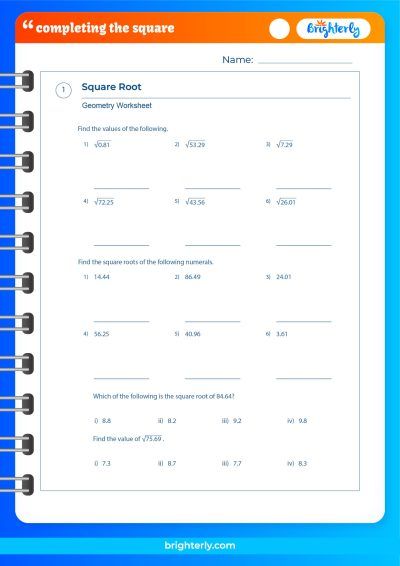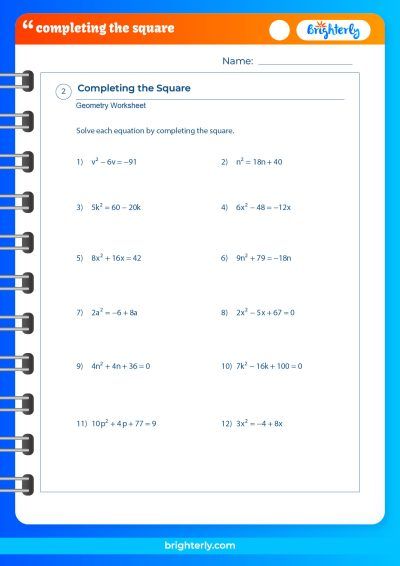Completing the Square – Definition with Examples
Updated on January 15, 2024
In the colorful and expansive world of mathematics, many concepts are like the pieces of a jigsaw puzzle, fitting together to form a coherent picture. At Brighterly, our mission is to guide young learners on their journey through this vast mathematical landscape, one concept at a time. Today, we explore the fascinating concept of “Completing the Square”.
Completing the square might seem like a cryptic term at first, but don’t be fooled by its complex appearance. As we unpack its meaning and explore its applications, you’ll discover that it’s a crucial mathematical tool that will open doors to advanced problem-solving techniques. Whether you’re grappling with quadratic equations or trying to make sense of geometric shapes, understanding the process of completing the square will give you an edge. So buckle up as we embark on an enlightening mathematical adventure with Brighterly!
What is Completing the Square?
In the realm of mathematics, some terms may sound complicated, but once you explore them, you will realize they are intriguing and enlightening. One such term is “Completing the Square”. Simply put, completing the square is a method used to solve quadratic equations. The name derives from the visual representation of the algebraic process where you arrange literal and numerical terms to form a perfect square on one side of the equation.
Completing the square is a fundamental mathematical concept that serves as a stepping stone for more advanced mathematical operations. The technique is immensely beneficial, especially in calculus and geometric equations.
Definition of Completing the Square
Completing the square refers to a technique employed in algebra to convert a quadratic equation of the form ax^2 + bx + c = 0 into the form (x-h)^2 = k, where x represents a variable, and a, b, c, h, and k are constants. This transformation simplifies the equation, making it easier to solve.
This method is so named because it involves arranging terms in the equation to resemble a squared binomial.
Explanation of the Completing the Square Process
The process of completing the square involves a series of steps that require rearranging and simplifying the quadratic equation. We begin by ensuring that the coefficient of the x^2 term is 1. If it isn’t, we divide the entire equation by the coefficient to make it so.
Next, we take the coefficient of the x term, halve it, square the result, and then add and subtract that value in the equation. This creates a perfect square trinomial in the equation, which we can rewrite as the square of a binomial.
The process of completing the square uncovers the roots of the equation, thus making it an essential algebraic skill.
Purpose of Completing the Square
The primary purpose of completing the square is to simplify quadratic equations, making them easier to solve. This method is fundamental in the development of the quadratic formula, a universally applicable formula for solving any quadratic equation.
Beyond solving equations, completing the square is also vital for graphing quadratic functions, as it allows us to convert quadratic equations to vertex form. This makes it easier to identify key features of the graph, such as the vertex and the axis of symmetry.
Uses of Completing the Square in Mathematics
The uses of completing the square in mathematics are vast and varied. It’s a fundamental technique used in algebra, calculus, and geometry.
In algebra, completing the square is used to derive the quadratic formula, which can solve any quadratic equation.
In calculus, the method is used to integrate certain types of functions and also when finding the area enclosed by a curve.
Finally, in geometry, completing the square plays a key role in deriving equations for circles, ellipses, and hyperbolas.
Detailed Steps in Completing the Square
Now, let’s delve deeper into the detailed steps involved in completing the square:
- Step 1: Start with a quadratic equation in the standard form
ax^2 + bx + c = 0. - Step 2: If
a ≠ 1, divide the entire equation byato make the coefficient ofx^2equal to 1. - Step 3: Rewrite the equation as
(x^2 + bx) + c = 0. - Step 4: Add and subtract the square of half of the coefficient of
xwithin the parentheses. - Step 5: Simplify the equation, which should now be in the form
(x-h)^2 = k.
By following these steps, you can complete the square of any quadratic equation.
Different Forms of Quadratic Equations and Their Relation to Completing the Square
Quadratic equations can be written in three forms: standard form, vertex form, and factored form. Completing the square serves as the bridge between these different forms, making it possible to convert from standard form to vertex form or factored form.
Standard form ax^2 + bx + c = 0 is the common representation of a quadratic equation. However, by completing the square, we can convert this standard form into vertex form (x-h)^2 = k, which provides a clear picture of the vertex and the axis of symmetry of the function’s graph.
At Brighterly, we believe that practice is the key to mastery. That’s why we invite you to explore our completing the square worksheets, where you can find an array of additional practice questions, complete with answers.
Difference Between Factoring, Quadratic Formula, and Completing the Square
Factoring, the quadratic formula, and completing the square are all methods of solving quadratic equations. However, they differ in terms of complexity, applicability, and ease of use.
Factoring involves expressing the equation as a product of its factors. It’s the simplest method but only works when the equation can be easily factored.
The quadratic formula x = [-b ± sqrt(b^2 - 4ac)] / 2a is a universally applicable method, derived from the process of completing the square. It can solve any quadratic equation but may be seen as complex due to the involvement of the square root and fraction.
Completing the square stands as the middle ground between the two. It’s more versatile than factoring and simpler than the quadratic formula, but it requires understanding of how to rearrange and simplify terms to create a perfect square trinomial.
Equations involving Completing the Square
Let’s look at an example of an equation where completing the square is used: x^2 + 6x - 7 = 0.
We first rewrite the equation as (x^2 + 6x) - 7 = 0. Then, we add and subtract (6/2)^2 = 9 within the parentheses, yielding (x^2 + 6x + 9 - 9) - 7 = 0.
Simplifying further, we get (x + 3)^2 - 16 = 0, which is easier to solve.
Writing Quadratic Equations Using Completing the Square
Writing a quadratic equation using completing the square can provide a clearer understanding of the equation’s properties.
Let’s take x^2 - 4x + 4. First, identify the value of b in the equation, which is -4. Divide this by 2 to get -2, then square it to get 4.
The equation is already in the form (x-2)^2, indicating the vertex of the graph and the axis of symmetry.
Solving Quadratic Equations by Completing the Square
Solving quadratic equations using completing the square involves a few simple steps.
For instance, given the equation (x + 3)^2 - 16 = 0, we start by isolating the squared term by adding 16 to both sides of the equation, yielding (x + 3)^2 = 16.
We then take the square root of both sides, remembering to include both the positive and negative square root, which gives us x + 3 = ±4.
Finally, we subtract 3 from both sides to get x = -3 ± 4, which gives us the solutions x = 1 and x = -7.
Practice Problems on Completing the Square
- Complete the square for
x^2 + 8x - 9 = 0. - Solve
x^2 - 6x + 1 = 0by completing the square. - Write
x^2 - 10x + 25in vertex form.
These problems will help reinforce the concepts learned and develop proficiency in completing the square.
Frequently Asked Questions on Completing the Square
What is completing the square used for?
Completing the square is a versatile tool in mathematics. It’s primarily used to simplify quadratic equations, transforming them into a format that’s easier to solve. By arranging the terms of the quadratic equation to create a perfect square trinomial, we can easily find the roots of the equation. Furthermore, this technique plays a critical role in the derivation of the quadratic formula, an essential tool for solving any quadratic equation. Lastly, completing the square is also employed in the graphing of quadratic functions, as it aids in converting the equation into its vertex form, allowing us to easily identify key features of the graph, such as the vertex and axis of symmetry.
How does completing the square work?
Completing the square works by systematically manipulating the terms of a quadratic equation to form a perfect square trinomial, which can then be expressed as the square of a binomial. The process begins by making the coefficient of the x^2 term 1. Next, we look at the coefficient of the x term, divide it by 2, and then square the result. This value is added and subtracted in the equation, creating a perfect square trinomial that can be written as a squared binomial. The manipulation simplifies the quadratic equation and uncovers its roots, providing the solution.
Is completing the square always possible?
Yes, completing the square is a universally applicable technique and can be performed for any quadratic equation. Regardless of the coefficients of the equation, the process of completing the square can always be used to transform the equation into a format that reveals the roots of the equation. So, no matter how complex a quadratic equation might seem, rest assured, completing the square has got you covered!
What is the relationship between completing the square and the quadratic formula?
Completing the square and the quadratic formula are closely linked. In fact, the quadratic formula, which is used to solve any quadratic equation, is derived using the process of completing the square. During the derivation, the quadratic equation in standard form is manipulated via the process of completing the square, and this manipulation results in the quadratic formula. Hence, completing the square is not only a method to solve quadratic equations but also a fundamental step in the derivation of one of the most important formulas in algebra.






